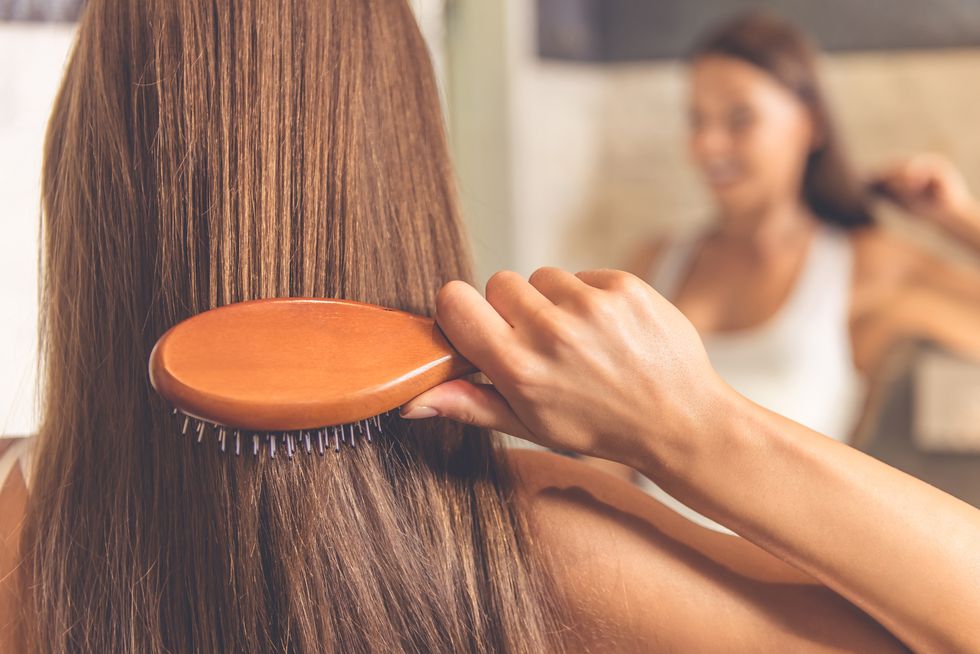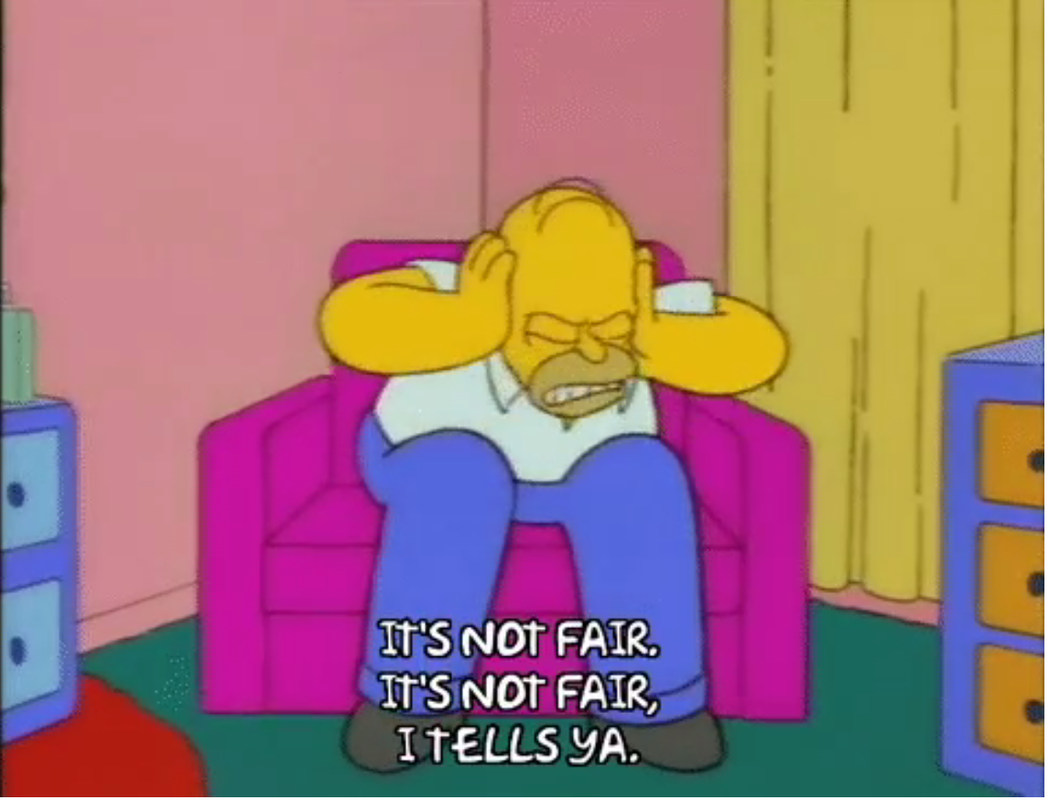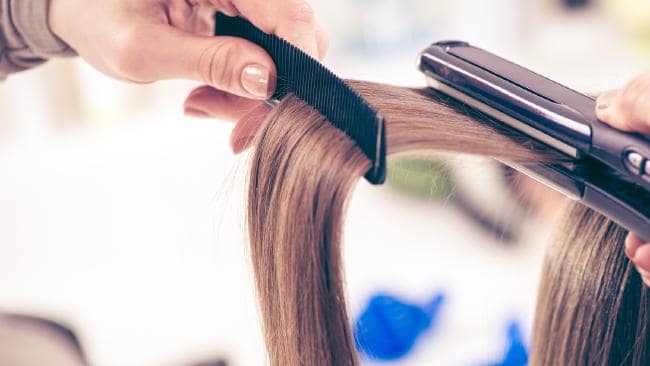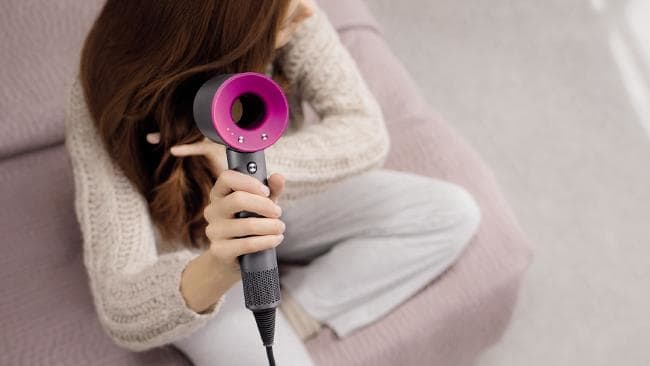|
Cue the celebration emoji—the scale is moving in the direction you want it to! But...then you start to notice that your hair is falling out. Like, a lot of it. WTH? Before you panic and assume you’re going bald, know this: What you're going through is completely normal. “We know that, clinically and anecdotally, hair loss is associated with rapid weight loss or weight loss associated with stress,” says Ken L. Williams Jr., D.O., a hair-restoration specialist, surgeon, and author of Hair Transplant 360 – Follicular Unit Extraction. In other not-fair news, the more weight you lose, the more likely you are to experience some form of hair loss, says Beth Warren, R.D.N., founder of Beth Warren Nutrition and author of Living a Real Life with Real Food. It all comes down to ~nutrients~, says Fatima Cody Stanford, M.D., M.P.H., an obesity medicine physician at Massachusetts General Hospital. People often don’t take in enough protein when they lose weight, she explains. And, when you don’t get enough protein, your body has to decide where to send the protein it does have. Given that your hair isn’t crucial to your survival, it gets the leftovers, Stanford says—and that can lead to hair loss.
Ready for the good news? This is temporary. “When people stop losing weight, the hair loss usually resolves itself,” Warren says. If you’re planning to lose a lot of weight and want to minimize the...er...fallout, try keeping tabs on how much protein you’re getting, and aim to get your recommended daily amount—that would be 46 grams. It’s also a good idea to try to get some zinc in your diet, Stanford says, since it's a key mineral for hair growth (as well as skin and nail growth). You can get it by eating:
You may also want to take a zinc supplement to be totally sure you’re getting enough, says Stanford. (Just check in with your doctor first, which is a must before taking any kind of supplement.) If you do start to lose your hair, despite your best efforts, and it’s bothering you, Williams recommends taking a biotin supplement or even a prenatal vitamin, both of which have a lot of extra vitamins your body probably is probably craving right now. You can also try monoxidil (a.k.a. Rogaine), which stimulates hair growth, he says. And in the meantime, repeat after me: "This is not permanent." This article first appeared on Women's Health HE’S behind one of the world’s most iconic hair products. But the professor behind GHD says we are making a big mistake when straightening. THE name Dr Tim Moore probably doesn’t mean much to many of us, even if you are a fanatic when it comes to the world of beauty. But this professor from Cambridge University is responsible for perhaps one of the most iconic hair styling products in the world — the GHD hair straightener. Standing for ‘Good Hair Day’, Dr Moore says despite the bloggers and vloggers giving anyone, anywhere advice on how to style their hair — there’s still a big misconception when it comes to using a styler. Speaking to news.com.au while in Sydney for their latest style, the GHD Platinum +, Dr Moore said some of the biggest mistakes not only cause damage to hair follicles — but also stops a style from lasting all day. “There’s a lot of miscommunication when it comes to temperature,” Dr Moore told news.com.au. “Your hair consists of three kinds of bonds. Putting your styler at the hottest temperature is not the key to getting your hair how you want it. “You don’t need anything above 185 degree celcius (365 degrees Fahrenheit), because using anything above that creates vertical cracks along the cuticle, causing the cuticle to lift and resulting in tangles and splits. “Trying to style your hair below 185C will often take many passes of the tool to achieve a good result, which is more drying to the hair and causes further split ends.” While it should come as no surprise that styling your hair with heat can cause damage — we’ve all been there when it comes to cranking up the heat in the hope your style will last a little longer. “Temperatures that break the hair bond is 200C degrees,” he explained. “The higher the temperature, it can change the colour of the hair too. These people going to 230C degrees … it’s really bad news and you will cause significant damage.” Dr Moore, who joined the GHD team in 2008 and created their Research and Development lab, spends most of his time working on how to develop and change their stylers to overcome any damaging elements that feature in heat stylers available on the market. Dr Moore, who was in Sydney on Thursday for the launch of GHD’s Platinum+ smart straightener, said even a woman with curly or frizzy hair shouldn’t be turning up the temperature for a better style. In an interview with MamaMia, he explains straightening hair of different thickness was like boiling water. “Thick hair is like heating up 10 litres of water, as opposed to thin hair which is like heating up 1 litre of water,” he said. “You don’t need more temperature, but you need more energy.” And speaking of water, Dr Moore said only use styling products on completely dry hair. “If your hair is wet, the heated water will transform from a liquid to a gas and expand,” he said. “Water trapped in the cortex will burst out of the strand and damage it.” Dr Moore said their latest $340 styler, which will launch in September, was the “world’s first smart straightener” and used prediction to control heat and respond to the needs of your hair. Speaking of competitors in the market, including Dyson — who this year brought out the Supersonic hair dryer for $500 — he welcomed new competition to the ever growing beauty technology market. “They have brought out an interesting hair dryer,” he said. “But where we lead and are different to Dyson is that we do the fundamental research into hair. While they are a good competitor, we have a strong competitive edge in terms of the scientific needs of hair.” In response, Dyson said their range of haircare contains “intelligent heat control” as a mechanism to care for hair. “Research sits at the heart of everything Dyson does, particularly when entering a new category,” a spokesperson said. “Setting up our own state of the air hair laboratories is what enabled Dyson’s engineers and scientists to reveal the intrinsic issues with conventional hair dryers. During four years of intensive research, our testing revealed many conventional machines can reach unnecessary extreme temperatures.
“This is one of the key issues the Dyson Supersonic hair dryer has been designed to combat. Unlike many competitor products, the Dyson Supersonic hair dryer possesses intelligent heat control. A glass bead thermistor measures the temperature 20 times a second, never letting the machine exceed temperatures of 150 degrees.” This article first appeared on news.au.com The sun can leave hair dry, brittle and discoloured. Here’s how to fix it
We all know the damage the sun can do to exposed skin, but experts say it can also affect our hair. “If your hair is exposed to the sun for long periods of time, UVA and UVB rays can start to damage the outer layer of the hair called cuticle,” said hair stylist and colourist Frederic Bataclan of Loft Hair Lounge in Toronto. “The sun is very natural but it can make your hair very dry. Too much of one thing can be bad for you.” The Cleveland Clinic adds the sun’s rays basically act like bleach. “Bleach reacts with the melanin in hair and removes the colour in an irreversible chemical reaction. Bleach also damages the hair’s cuticle and protein, which is called keratin,” dermatologist Dr. Wilma Bergfeld said. Signs for hair types The most common signs of sun damage include discolouration of your ends, as well as your overall hair colour getting lighter (even if you don’t have dye in it). People may also have dry, brittle, overly-tangled, broken or whispy ends. “And lots of frizz,” he explained. “Sun-damaged hair also won’t hold the style as long and dries a lot quicker than healthy hair.” He adds people who have lightened hair (either through highlights, balayage or ombre), will experience the most sun damage. “They will find their toners don’t last as long due to the sun,” he continued. For people who have blond colour, the sun can turn it golden or brassy. For people with “fashion” colours like red, green, blue or multicolours, their hair will fade a lot faster in the summer. “People who have brunette hair will find their hair looks quite dull.” If you have fine hair, Bataclan said your hair will be flat and lifeless during the summer, and people with thin hair may experience irritated scalps or even a sunburn. “If left untreated, the hair will slowly break off due to dryness,” he adds. “The hair will be very tangled and unmanageable.” He adds people who don’t treat sun-damaged hair are often forced to cut it off until it grows back into a healthy state. “People with already thinning hair will accelerate the process of thinning.” How to treat sun damaged hair To start, Bataclan recommends a liquid keratin treatment. “It helps revitalize and protect your hair from the sun and lasts for up to four months.” You can also use serums that have jojoba oil or hair products that already have SPF in them. “Lastly, try to put a mask once a week during the summer. It will help to add moisture back into the hair that you’ve lost from the long exposure from the sun.” There are also products, like primers, that come with UV protectors — this can also help with taming frizz and detangling dry hair. Bergfeld said you should also avoid hot irons, rollers or chlorinated water in swimming pools. “If you bleach or highlight your hair, you’ve damaged the hair already,” Bergfeld explained. “To add to that by swimming in a chlorinated pool, or sitting out in the sun, you’re going to have very significant hair breakage.” Bataclan also recommends wearing a hat, and Bergfeld adds avoid peak sun hours just like you would do for your skin. This article appeared on Global News And there’s not a frosted tip in sight. I can live happily knowing that most late-’90s trends will never (hopefully?) be back in style: JNCO jeans and puka-shell necklaces are still buried in a time capsule. I pray they stay there. I would have said the same for guys getting highlights—I'm picturing Chris Kirkpatrick and Nick Lachey with their immortally frosted tips. But recently I’ve been seeing subtle highlights on the runway and in editorial spreads, and I have to say I don't hate it. Most recently, Chris Evans graced the cover of L’Uomo Vogue sporting a barely-noticeable-yet-definitely-lightened layer on top of his naturally darker hair.
He's not using highlights to stand out. He's using them to blend in, to add depth to his styles. “Everything we’re seeing now is understated, almost sun-soaked,” says Tyson Kennedy, co-owner of Cutler Salon in NYC. “Lately guys prefer a more natural look, working with the hair’s traits instead of forcing anything against the color, texture, and flow.” Kennedy attributes the highlight resurgence to a ramping-down of recent hairstyle trends, like the gray and platinum hair dyeing, as well as all of the “classic, structured barbershop looks” that have dominated for the past few years. “For a while, everything was bold and demanded attention,” he says. “We had slicked-back undercuts with shiny pomades and tight fades, lots of really strong looks.” Natural-looking highlights allow guys to loosen up, to relax. (Time to channel your inner surfer, brah?) I’ll take any excuse to look great with less effort. General chill-ness aside, it’s important to know the rules of highlights, since they don’t work for all hair types. To get it right the first time, memorize these 10 commandments before you head to the salon. And you will head to the salon, because the last commandment is the most important: Never do it at home. -- 1. You should get highlights if you want to add visual texture to your style. Think of the verb “highlight”: It means “to emphasize,” and that’s exactly what you’re aiming to achieve. You’re emphasizing the texture and layers of your hair with small pieces of slightly lighter color scattered throughout. Typically, your colorist will paint small clusters of hair, particularly around the hairline and very lightly back from there, on top of the head. Your highlights may not be the same as another guy’s. “It’s always done based on the hairline and the way that the hair naturally lies,” says Pamella Gonzalez, Cutler’s in-house colorist. So trust that your colorist will know what looks best. Usually, less is more. 2. …And if you want more physical texture. An added benefit of highlights is that they boost the grit of your hair, too. It’s perfect for guys whose straight hair falls limp without any styler. “We’re putting in bleach to lighten the hair, but what it’s really doing is expanding the cuticle so that your hair has more texture,” says Gonzalez. 3. Highlights should not be confused with hair dye. Highlights are supposed to look natural. They complement your natural tone by subtly contrasting themselves against the rest of your hair. If you merely bleach parts of your hair, or if you pick a vivid or unnatural color, then you’re technically not highlighting. Anything else is designed to draw attention to itself, where highlights are devised to draw attention to the overall, mostly natural look. 4. Guys with thinning hair should proceed with caution. Bad news for guys who are balding: While highlights usually add natural texture to the hair, it’s only the case for fuller styles. Some texturizing products can give you the illusion of fuller hair, but highlights won’t do the same. Gonzalez advises against coloring the hair, because the cuticle isn’t strong enough to take the chemicals and toner. You might compromise whatever it is you have left. 5. If you want to grow your hair out, it’s best to avoid artificial color. Your hair can only take so much wear, and coloring it (with bleach, dye, or highlights) will really compromise its health. “You don’t want to lighten the same pieces of hair more than once or twice,” says Kennedy. “This will really thin it out and strip the hair of its properties.” So if you’re getting haircuts every six weeks and chopping it off at regular intervals, then highlights are a great choice, since they’ll add movement, volume, and variety. Otherwise, focus your attention on healthy hair growth, since you’re playing a long game. 6. Certain hair colors shouldn’t be highlighted. “If you have dark brown hair, you don’t want to go lighter than a light brown,” says Gonzalez. “It’ll look artificial.” Luckily, guys with light brown and dark blond hair have more flexibility with tone options. You can go much lighter than one shade, because the contrast won’t be as high. (And thus it won’t detract from the overall natural look.) However, this is bad for guys with black hair: The contrast is so high that almost any highlights will detract from your natural color. Instead, you should praise the day that your natural grays start sprouting. 7. You’ll need color-preserving hair-care products. “You need some good silver shampoo,” says Kennedy, “especially if you go for a cooler blond. It can start turning orange or gold.” You might remember, during the gray-hair-dyeing trend, that some guys’ hair was turning purple. This was because they weren’t using the right shampoo to preserve the gray tone, and the same can be said of bleached or highlighted hair: You’ve already stripped the natural color and have replaced it with an artificial one. That artificial one can fade or change if you don’t treat it properly. 8. And you must treat it daily. Not only do you need to use a specific type of shampoo and conditioner, you’ll need to use them frequently—particularly the conditioner. It will keep the hair soft, which is critical after it’s been stripped of color and treated with toner. That grit you’ve added to the cuticle is great for styling but not terrific for the overall health of your hair. (Hence the reason guys with thinning hair shouldn’t color theirs.) Wash it every other day, and condition every single day. 9. Don’t confuse men’s highlights with women’s highlights. “Usually with men, we put in fewer highlights,” says Gonzalez. “We’re highlighting it to see nuances that you wouldn’t see if it were all solid. With women’s hair, however, it’s about getting an all-over lightened effect.” This is fairly universal across different hair lengths, too. Women will highlight larger clusters of hair, as if to let the darker roots show through, whereas men’s highlights flatter more when scattered strategically, like light undertones. 10. Always hire a professional. “You need to lift the color to the right tone, or else it’s going to be this chicken-fat yellow color,” says Gonzalez. “Most of the time, people who attempt this themselves will have busted-looking highlights. They’ll bleach the hair and then rinse it off without toning it. Or they’ll tone it with permanent color and lift all the natural color, making it orange.” Simply put: Just go to the professionals, and you won’t have any regrets. This article appeared on GQ Marilyn Monroe may be an iconic blonde, but she certainly wasn't the first to make us adore this hair color. Back in the (seriously) olden days, women used to try to bleach their locks with everything from horse urine to pigeon dung. (We don't recommend you try that at home.) And still today, there are so many influential blondes that we see all the time in the media, such as Blake Lively, Jessica Simpson, and Anna Faris.
Whether you come by your blonde hair "legally" or make that faithful appointment with your stylist every six to eight weeks, here's what you need to know about this preternaturally playful hair color. 1. Being naturally blonde is pretty rare. Only 2 percent of people in the world are natural blondes. (About one in 20 Americans are.) But that doesn't mean it's not popular. One in three women dyes her locks light enough to be considered blonde. 2. Blonde hair comes from a teeny-tiny genetic mutation. How tiny? Think one letter change among 3 billion letters that make up a person's DNA. 3. Blondes aren't blondes forever. (Naturally, at least.) Many kids born with light hair go dark before their tenth birthday, thanks to rising levels of eumelanin, a natural pigment that regulates the darkness of hair strands. 4. Having blonde hair doesn't necessarily mean having blue eyes. It's a stereotype. Although red hair, light eyes, and light skin do tend to go together, blondies can have eyes that are blue, green, brown, and more. 5. There are 50 shades of gray ... and 30 shades of blonde. Yep, there are really that many hair hues that can be considered blonde. For instance, Taylor Swift has café au lait locks; Gwen Stefani's are golden platinum; and Cara Delevingne rocks a gray-blonde. (Beyonce's a "brownde" -- a brownish-blonde -- just FYI.) 6. Blond-haired, blue-eyed men are blonde women's biggest fans. The reason has roots in evolutionary psychology. Both blonde hair and blue eyes are recessive traits, so both parents must carry the gene for blonde hair to pass it on to their kids. Some scientists think men with light hair and eyes are instinctively drawn to women with the same coloring. That way, he'll know for sure he's the dad of any offspring. 7. Blondes not only have more fun -- they have MORE hair. Most people have about 120,000 hairs on their head, but people with light-colored locks tend to have even more. The reason? Blonde hair is finer than other colors, so the scalp can hold more individual strands. 8. Many gentlemen (probably do) prefer blondes. Several published studies have found that men find blondes more attractive than women with other hair colors. Blonde women are most likely to be picked up in a bar. Heck, they're also more likely to be helped by a man when they drop something on a sidewalk. 9. But there's a dark side to men's attraction, too. Research published in the Scandinavian Journal of Psychology found that men tend to think blondes are usually needy, high-maintenance, and neurotic. (So, stop trying to pick us up in bars already then!) 10. Forget "dumb blonde" -- blondes make men act dumb. Although, not for the reasons you might think. When French men were shown pics of blonde women, and then were given a general knowledge test, they scored worse on it than when they looked at images of dark-haired women. The reason? Researchers say the stereotype of "dumb blonde" is so ingrained that men were simply behaving in kind. Oookay, or maybe they're just dumbfounded by our beauty! 11. But blondes get the last laugh! Researchers at the University of Queensland found that not only are blonde women paid more than their peers with other hair colors, but they're also more likely to marry a wealthier man. This article first appeared on cafemom |
Hair by BrianMy name is Brian and I help people confidently take on the world. CategoriesAll Advice Announcement Awards Balayage Barbering Beach Waves Beauty News Book Now Brazilian Treatment Clients Cool Facts COVID 19 Health COVID 19 Update Curlies EGift Card Films Follically Challenged Gossip Grooming Hair Care Haircolor Haircut Hair Facts Hair History Hair Loss Hair Styling Hair Tips Hair Tools Health Health And Safety Healthy Hair Highlights Holidays Humor Mens Hair Men's Long Hair Newsletter Ombre Policies Procedures Press Release Previous Blog Privacy Policy Product Knowledge Product Reviews Promotions Read Your Labels Recommendations Reviews Scalp Health Science Services Smoothing Treatments Social Media Summer Hair Tips Textured Hair Thinning Hair Travel Tips Trending Wellness Womens Hair Archives
April 2025
|
|
Hey...
Your Mom Called! Book today! |
Sunday: 11am-5pm
Monday: 11am-6pm Tuesday: 10am - 6pm Wednesday: 10am - 6pm Thursday: By Appointment Friday: By Appointment Saturday: By Appointment |










 RSS Feed
RSS Feed